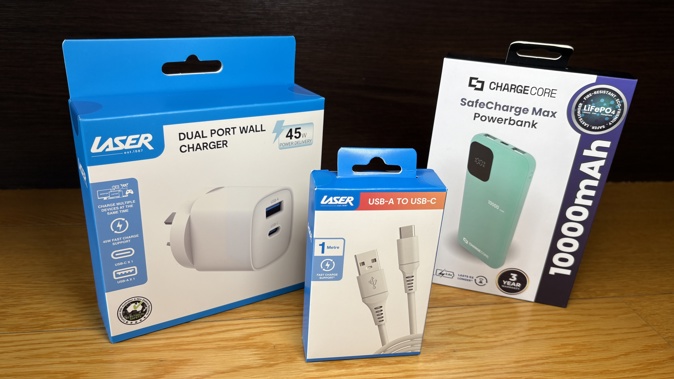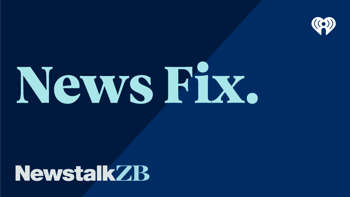
We all have them.
Most of us have far too many of them.
In fact, some us have so many, we're not even sure what they're all for.
So we stash them in a drawer or a cupboard thinking they'll probably come in handy one day.
And maybe one or two did. But let's be honest; most of them are still in that drawer.
Chargers and cables. Some of my drawers are so full I can't open them properly.
Even when we throw away the thing the charger charges, we often still keep the charger and the cable.
In fact, because we did that, for many products, the tech brands stopped including chargers in the box.
So that equation will probably correct itself, right? Eventually we'll end up with the right amount of chargers per device and we're bound to have the exact cable required. Hmmm.
I think you can see where I'm going with this.
Looks like Laser has brought its range of high-quality - yet reasonably priced - charging accessories to New Zealand at just the right time.
We'll get to one of the best power banks I've ever used shortly but first, it's time to have a serious talk about chargers and cables.
For a long time there it was true; those little bricks you plugged into the wall, with a USB slot for your cable, were pretty much the same. They cranked out 5V at somewhere between 1A and 2A and it was pretty unusual to find anything different.
Then, not only did the charging demands of the devices we were buying change, so did the cable standards. Goodbye, microUSB. Goodbye USB-A. And yes, after far too long, goodbye to Lightning cables too.
If you don't know the difference between any of those, don't worry, you're not alone. Luckily, thanks to the EU's somewhat heavy-handed regulations, pretty much everything now charges via USB-C. So that means the same cable for everyone, doesn't it?
Not by a long shot. If anything, things have become even more confusing because different cables now look essentially the same.
What's worse is phones, laptops, tablets, watches, speakers and earbuds all charge at different speeds - many faster and faster every generation.
But only if you have the right charger and the right cable. That's right, not all USB-C cables do the same things - some can carry large amounts of data at sizzling speeds while others are for power only - and possibly not even as much power as you would like.
As for those old wall chargers, give them a good hard look - maybe under a magnifying glass. There'll be some tiny print on there - often not even in a contrasting colour - to tell you how many Volts and how many Amps you'll be getting. If you're charging a toothbrush, it probably won't matter much. If you want to charge your phone, your watch and your earbuds all at the same time... forget it.
For about NZ$45.00, you can save yourself at least two headaches by snapping up the Laser Dual Port 45W USB Wall Charger. If you just use the USB-C port on its own, it'll charge at 45W - that's even enough for some laptops and means "fast charging" for any capable phone.
USB-A ports are more limited but at least the one on this charger puts out a 20W charge with enough voltage to run the majority of those three-device wireless chargers many people have on their bedside table for buds, watch and handset.
Even when both ports are in use, you'll get up to 25W from the USB-C and 18W from the USB-C - making this a very compact and convenient travel buddy, providing plenty of juice for at least two devices simultaneously.
But what about when there's no wall to plug into? Nothing worse than being out and about watching your phone go flat.
That's where Laser's ChargeCore SafeCharge Max comes in.
Again, like wall-chargers, you might be thinking, "Why are you telling me about this? I already have a power bank."
Well, if it's anything like the majority of power banks I've tried over the years, your old one is next to useless - and possibly even dangerous.
The ChargeCore SafeCharge Max is different in a number of ways - starting with how many devices it can charge at once. There are two USB-A slots, a USB-C and a three-way cable included in the box. That cable is USB-A at one end, then splits into two USB-C and a Lightning plug at the other. This makes it another handy travel tool.
Not only does it come in a variety of colours and capacities, it also features a digital LED display so you can see exactly how much charge is left as a percentage. This is so much more useful than a set of three lights that could mean low, medium or high charge. Or even worse, a single LED that might change colour when charge is getting running out.
But probably the most important thing to know about Laser's ChargeCore SafeCharge range is what they're made of; Lithium Iron Phosphate - known as LiFePO4.
Not only will a LiFePO4 power bank charge up faster and charge other devices more efficiently, it'll last much longer - up to five times the lifespan of conventional lithium-ion products.
LiFePO4 is safer too - the ChargeCore SafeCharge Max stays cool and won't swell.
And the best feature of all? Once charged, it stays charged. How often have you reached for your power bank only to discover it's gone flat since you last charged it? Not helpful. For the last few days I haven't used my ChargeCore SafeCharge Max 10K but I've checked the battery level (by pushing the button on the side) regularly. It's still on 100%, ready to go.
The point to all this is not all charging devices are created equal. Some are useless and others might be downright hazardous. My advice is to use the chargers and cables that came with your device wherever you can. But if you can't, always read that tiny fine print on the plug or better still, maybe just empty out that jammed drawer and treat yourself to some nice, new chargers and cables from Laser.
Click here for more information and pricing on the Laser ChargeCore SafeCharge Max.
Click here for more information and pricing on the Laser Dual Port 45W USB Wall Charger.
Take your Radio, Podcasts and Music with you













